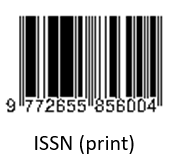Comparison the adsorption of Pb with Ecofriendly Bio-Adsorbent From Rice Husk Ash and Boiler Fly Ash
(1)
(2) Politeknik Teknologi Kimia Industri Medan
(3)
(4)
(5)
(6)
(*) Corresponding Author
Abstract
Full Text:
PDFReferences
. Dashti, Arezoo Fereidonia, Mohd Omar Fatehah, Mohammad Ali Zahed, Waste management of the palm oil industry: present status and future perspective, Journal of Enviironmental Engineering and Science, 17(2), (2022), 75-88.
Telaumbanau, Juang Jaya Putra, Using Fly Ash and Bottom Ash Boiler of Palm Oil Factories as Adsorbents for Adsorption of Color in Artificial Liquid Waste, Jurnal Mekintek, 11(2), (2020),59-67.
Farandia, R Y, Monita Olivia, Lita Darmayanti, Kinerja Beton High Volume POFA, Jurnal Online Mahasiswa (JOM) Bidang Teknik dan Sains, 1(1), (2015).
Liu, Michael ong Jing, Choon Peng Chua, U. Johnson Alengaram, and Mohm Zamin Jumaat, Utilization of Palm Oil Fluel Ash as Binder in Lightweight Oil Palm Shell Geopolymer Concrete, Hindawi Publishing Corporation Advances Amterial Science and Engineering, 2014(12).
Hossain, SK S, Lakshya Mathur & P.K. Roy, Rice Husk ash as an alternative source of silica in ceramics: a review. Journal of Assian Ceramic Societies, 6(4), (2018), 299-313.
PTPN.,Material Balance Pengolahan Kelapa Sawit. Pekanbaru, (2011).
Riyadi, Muhtarom, Pemanfaatn Abu Sekam Padi sebagai Substitusi Sebagian Semen pada Mortar Semen Pasir, Politeknologi, 12(5), (2013), 39-46.
Pratiwi, R., Prinajati, D.P.S., Adsorption for lead removal by chitosan from shrimp shells.Indonesian, Journal of Urban and Environmental Technology, 2(1), (2018), 35-46.
Arita, Susila, Devi Kristianti, Leily Nurul Komariah, Effectiveness of Biomass-Based Fly Ash in Pulp and Paper Liquid Waste Treatment, South African Journal of Chemical Engineering, 41, (2022), 79-84.
Syauqiah, Isna, Mayang Amalia, Hetty A. Kartini, Analisis Variasi Wkatu dan Kecepatan Pengaduk pada Proses Adsorpsi Limbah Logam berat dengan Arang Aktif, Info Teknik, 12(1), (2011), 11-20.
Tandung, Mutiara Rante, Sayidina Nur, Mardiah, Utilization of Palm Boiler Ash as Air Catode Material in Air Aluminium Battery. Jurnal Chemurgy, 04(2), (2020), 38-44.
Nurhasni, Penyerapan Ion Logam Cd dan Cr dalam Air Limbah Mneggunakan Sekam Padi, Tesis Universitas UIN Syarif Hidyatullah: Jakarta, (2014).
Okoro, Hussein K., Sikirat M. Alao, Sadanand Pandey, Simaila jimoh, Kazeem A. Basheeru, Zvinowanda Caliphs, Jane C. Ngila, 2022, Recent Potential Application of Rice Husk as an Eco-friendly adsorbent for removal of heavy metals, Springer Applied Water Science, 12(259).
Utama, Panca Setia, Ram Yamsaengsung, Chayanoot Sangwichien, Silica Gel Derived from Palm Oil Fly Ash, Songklanakarin J.Sci. Technol., 40(1), (2018), 121-126.
Poo-arporn, Yingyot, et al., The Investigation of SiO2 structure obtained from the combustion of rice husk, International Conference on Engineering and Industrial Technology-IOP Publishing, (2020).
Utari, N. P. S. N., I W. Sudiarta, dan P. Suarya , Sintesis Dan Karakterisasi Silika Gel Dari Abu Vulkanik Gunung Agung Melalui Teknik Sol-Gel, Jurnal Kimia (Journal of Chemistry), 14(1), (2020), 30-36.
Huang, Fengwei, Huimin Hao, Wenlong Sheng, Xianjun Lang, Dye-TiO2/SiO2 assembly photocatalysis for blue light-initiated selective aerobic oxidation of organic sulphides, Chemical Engineering Journal, Vol. 423, (2021).
Hardyanti, Ika Sri, et al., Pemanfaatan Silika (SiO2) dan Bentonit sebagai Adsorben Logam Berat Fe pada Limbah Batik, Jurnal Sains Terapan, 3(2), (2017) ,37-41.
Mujiyanti, Dwi Rasy, Radna Nurmasari, Nurhikmah, Adsorption Pb(II) on Silica Gel from Rice Husk Ash, Sains dan Terapan Kimia, 10(1), (2016), 33-38.
Givianrad, M.H., Rabani, M., Saber-Tehrani, M., Aberoomand-Azar, P., Hosseini Sabzevari, M., Preparation and characterization of nanocomposite, silica aerogel, activated carbon and its adsorption properties for Cd (II) ions from aqueous solution, Journal of Saudi Chemical Society, 17, (2013) 329-335.
DOI: https://doi.org/10.24071/ijasst.v6i1.7173
Refbacks
- There are currently no refbacks.
Publisher : Faculty of Science and Technology
Society/Institution : Sanata Dharma University

This work is licensed under a Creative Commons Attribution 4.0 International License.











